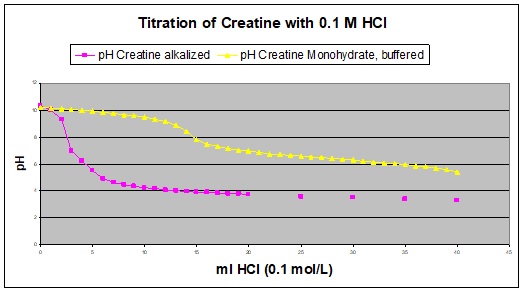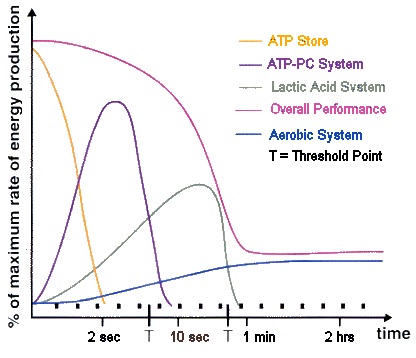
BY CREAPURE® pH 10
NO LOADING PHASE
NO WATER RETENTION
INCREASE PHYSICAL PERFORMANCE
FOR POWER AND ENDURANCE ATHLETES
30 DAYS PACKING
Get up to 35 point(s) for purchase! Login to see an actual value.
Creapure® pH 10 is the double buffered version of Creapure®, worldwide recognized as the benchmark for creatine quality. Creapure® pH 10 is previously known as Crea-Trona®.
Double Buffered Creatine is obtained by adding a double buffer of sodium carbonate and sodium bi-carbonate to Creapure®. These are both natural minerals that create an alkaline environment with a pH value (degree of acidity) between 9 and 11.Double Buffered Creatine is far more efficient than other types of creatine, including those that have an alkaline pH-buffer (kre-alkalynes). The double buffer prevents the pH-value in the muscles from dropping during the workout, leading to an increased workout capacity and a larger training volume.
On the chart below, you can find a relevant comparison between Creapure® pH 10 and kre-alkalynes:

The chart shows that the favorable pH-value not only lasts longer, but is also more stable. This leads to an improvement of the metabolization, which means that less creatine is converted into creatinine, and also that acts as an efficient lactic acid buffer, leading to better performance.
As Double Buffered Creatine is fully metabolized by the muscles and converted into creatinine to only a very limited extent, you only have to take 3g per day in order to get optimal results. Creatine increases physical performance in successive bursts of short-term, high intensity exercise.⁽¹⁾ That’s why it is suited for fitness, body building, martial arts, sprinting and other explosive sports. Also cyclists, football players need to accelerate and are therefore using the ATP energy system during their sport. To optimize the use of the different energy systems, creatine is often combined with beta-alanine. This combination is more efficient on strength performance than creatine alone.⁽²⁾
Suited for:
Fitness / Body Building⁽³⁾⁽⁴⁾
Athletics⁽⁵⁾⁽⁶⁾⁽⁷⁾⁽⁸⁾
Rugby / Soccer⁽⁹⁾⁽¹⁰⁾
Swimming / Rowing⁽¹¹⁾⁽¹²⁾
Basketball
Martial Arts / MMA / Boxing
Cycling
On Training Days: take 2 caps (=1 serving) 20 minutes before your workout and 2 caps immediately after your workout.
On Non-Training days: take 2 caps in the morning and 2 caps in the afternoon between meals.
Double Buffered Creatine Monohydrate
How does Creatine work?
Creatine is an endogenous substance that is present in every human cell. It functions as an energy storehouse. In the body, creatine is synthesized from the amino acids glycine, arginine, and methionine, primarily in the liver, kidneys, and pancreas, and it is transported from there to all the cells in the body via the bloodstream. Since creatine is involved in all processes that require energy, the muscle, brain and nerve cells receive correspondingly larger amounts.
Creatine is primarily involved in muscle contraction. It is taken up from the blood into the cell membrane by means of a sodium-dependent creatine transporter.
All the cells of the human body use adenosine triphosphate (ATP) as their sole source of energy. When a cell needs energy, one phosphate is split off from ATP. This process releases energy and converts “high-energy” ATP into “low-energy” adenosine diphosphate (ADP). The phosphate that was split off binds to creatine, forming phosphocreatine (CP). Phosphocreatine then releases the phosphate back to the ADP, and this process “recharges” the ADP which becomes high energy ATP again. So with the help of the energy store phosphocreatine, it’s possible to continually regenerate ATP. Phosphocreatine levels and the regeneration of ATP play key roles when the body is involved in intense, repetitive forms of exertion. Increasing the amount of creatine and phosphocreatine speeds up the regeneration of ATP, which leads directly to the release and availability of more energy. Creatine supplementation increases the amount of creatine in muscle tissue.

Figure 1: Energy pathways⁽¹³⁾
Orally administered creatine is absorbed by the intestines and then goes into the bloodstream. Small doses of creatine result in maximum blood plasma concentrations after fewer than two hours.
For concentrations of creatine in muscles there appears to be an upper limit that cannot be extended (~160 mmol per kg muscle dry matter). Ongoing supplementation with large amounts of creatine does not raise the levels of creatine in muscle anymore, so is not recommended.
|
Ingredients |
Per 4 Vcaps |
|
Creatine Monohydrate by Creapure® pH 10 |
3g |
Creapure® pH 10 Double Buffered Creatine Monohydrate, Vegetal Capsule (E464), Gelling Agent (Magnesiumstearate)
European Food Safety Authority. Creatine increases physical performance in successive bursts of short-term, high intensity training. EFSA Journal 2011;9(7):2303.
Hoffman J et al. Effect of creatine and beta-alanine supplementation on performance and endocrine responses in strength/power athletes. Int J Sport Nutr Exerc Metab. 2006 Aug;16(4):430-46.
Rawson ES et al. Effects of creatine supplementation and resistance training on muscle strength and weightlifting performance. J Strength Cond Res. 2003 Nov;17(4):822-31.
Burke DG et al. Effect of creatine supplementation and resistance-exercise training on muscle insulin-like growth factor in young adults. Int J Sport Nutr Exerc Metab. 2008 Aug;18(4):389-98.
Law JL et al. Effects of two and five days of creatine loading on muscular strength and anaerobic power in trained athletes. J Strength Cond Res. 2009 May;23(3):906-14.
Lanhers C et al. Creatine Supplementation and Lower Limb Strength Performance: A Systematic Review and Meta-Analyses. Sports Med. 2015 Sep;45(9):1285-1294.
Kreider RB. Effects of creatine supplementation on performance and training adaptations. Mol Cell Biochem. 2003 Feb;244(1-2):89-94.
Deminice R et al. Effects of creatine supplementation on oxidative stress and inflammatory markers after repeated-sprint exercise in humans. Nutrition. 2013 Sep;29(9):1127-32.
Chilibeck PD et al. Effect of in-season creatine supplementation on body composition and performance in rugby union football players. Appl Physiol Nutr Metab. 2007 Dec;32(6):1052-7.
Mujika I et al. Creatine supplementation and sprint performance in soccer players. Med Sci Sports Exerc. 2000 Feb;32(2):518-25.
Mero AA et al. Combined creatine and sodium bicarbonate supplementation enhances interval swimming. J Strength Cond Res. 2004 May;18(2):306-10.
Juhász et al. Creatine supplementation improves the anaerobic performance of elite junior fin swimmers. Acta Physiol Hung. 2009 Sep;96(3):325-36.
MacKenzie, B. Energy Pathways. 1998. Available from www.brianmac.co.uk/energy.htm